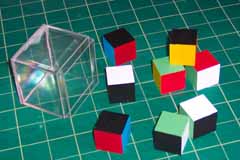EPP4: Puzzle DecathlonUpdate 16 April 2006: The Decathlon is Complete! Congratulations to all of the players of EPP4, and especially the winning teams:
Congratulations to all of the players of EPP4, and especially the winning teams:
As I had hoped this Party was a slightly smaller affair than my previous ones. I only had to make one copy of each puzzle, and the teams were smaller. A couple of people showed up at the last minute... which was great... they filled out the roster since a few teams had to drop out at the last minute. There were thirteen Players total, and I think we all had a good time. I hope that everyone found at least some of my puzzles interesting and perplexing. The atmosphere, in general, seems a little more laid back, the grading between rounds was a breeze for me, and the worst hiccup was the malfunctioning of the cheap stopwatch I'd bought that morning from Wal-Mart. A couple of the puzzles proved to be killers. No team solved the Su-Domino-Ku or the Pair O' Dice puzzles within the allotted 25 minute rounds. These were both "all-or-nothing" Point puzzles... and every team earned "0" (I remember now that at some point I was considering making Pair O' Dice a partial Point puzzle, and I wish I'd remembered to do that... but it slipped my mind).
I'm sure, looking back when all was done, every Player thinks he or she could have, should have, or would have done some small things differently. At this Party the small things really did make the difference. Going into the last round the top three teams were separated by only 4 Points, and each of those three teams had an all-or-nothing (0/100) Point puzzle to tackle. Tim and Ed had it the hardest of those three teams: having to attempt Cubic Rubes (pictured here held by Tracy Cobbs), which proved to be too tricky for most teams. Even though they did not solve it, they kept their third place standing (Robert Ford, a team unto himself, was a strong 4th Place, but could not catch Tim and Ed). That left Tracy & Mark (2nd) and Mike & Kelly (1st, by one Point going into round 10). Tracy and Mark had the easier task: solving Global Equality. They did this in about 10 minutes; so for the rest of the final round they were anxiously (but discreetly) eyeing "Team Hollingsworth" as they tackled the Four Dimensonal Maze. This was a toss-up. The Maze had proven too tricky for some teams, but others (especially those who had looked at the preview mazes on this website) had either solved it or came VERY close. Would Mike and Kelly finish it (even though they had only just looked at the examples that morning before the Decathlon)? They just pulled it off. With about one minute to spare they finally filled in the last path segment (which they had accidently erased). And with that they maintained their 1 Point lead over Tracy and Mark. It doesn't get more edge-of-your-seat (or geeky) than that! Congratulations, again, to everyone. I hope it was fun for all. I forgot to take any pictures, but Mark Brady has promised to send me some. If any Players want to type up short or long accounts of their experiences, I'll be happy to post those along with any pics I get. This Party went so smoothly that I'm pretty sure all of my future springtime Parties will be of this format (round-robin puzzle Decathlons). That will afford me plenty of time to concentrate on the more ambitious autumn Parties. Speaking of which... it's never too early to start talking about EPP5: Auburn's First PuzzleHunt. Thanks again to everyone who played. - Eric The Final Scoreboard
IntroductionWell, because of the intense amount of preparation I had to go through for EPP3: Puzzles From Wonderland, I have decided to make my fourth Party a little bit smaller in scope (this will also give me more time to prepare for the ambitious EPP5: Auburn PuzzleHunt!).
EPP4 will be a "Puzzle Decathlon" and have yet another new format (eventually I will repeat a Party format...). Here are my ideas about it:
The Decathlon will consist of 10 puzzles (I will have only one copy of each made). Each team will start at a different puzzle and have 30 minutes to try and complete it. After 30 minutes, time will be called, there will be a 5-10 minute break as I grade and reset the puzzles, and then each team will shift places so that they have the next puzzle to tackle in the next half hour. After ten half hour "rounds" each team will have attempted each puzzle. Scores will be kept track of throughout the day, and at the end, the highest score wins. I will award "gold", "silver", and "bronze" medals to the 1st, 2nd, and 3rd place teams. Pizza will be ordered for everyone as per tradition. The ease of all of this for me, as referee and puzzle creator, is that I only need one copy of each puzzle. The Teams
Because of the format of the Party I can only have 10 teams maximum, and with a 2 person limit per team, obviously this means an upper limit of 20 players. I don't suspect this will be a problem, however, as I know some people are not as comfortable with the physical/spatial type puzzles, so I may not get as many participants (remember, I'm thinking "smaller Party" this time). However, I don't want to discourage enthusiastic people from showing up. If there does turn out to be a high demand, I will cook up some scheme to allow more players. Also, if people just want to come and watch others solve puzzles (spectator sport?!), they are more than welcome to do so. I would encourage players who feel "strong" with this type of puzzles to not pair up in an attempt to have a dominating team -- I'd prefer strong players to all be on separate teams, if possible. The idea of having a partner is more to be paired with someone who might not feel as expertly skilled at these things, but wants to have fun, be on a team, and maybe help out here and there (or maybe just get more acquainted with this type of puzzle and see a solver "in action"). I will leave it up to players to organize into teams beforehand, but might ask to pair up people at the last minute, on the day of the event, if I need to lower the number of teams or such. If you decide to participate, just let me know and I'll post your name on this page as a player (you can also join and post to the Yahoo! Group that is set up about my Puzzle Parties in an attempt to find teammates). The Puzzles
Well, unlike past parties, there will be no word puzzles, and a limited number manipulation puzzles. The Decathlon will focus on mechanical, physical, and assembly puzzles. They will all be original ones that I have created just for the Party (though some may be similar to past puzzles I have made). Anyone who has wandered about my home has undoubtedly seen many of my creations. That is the type of puzzle I will have at the Decathlon. Scoring will be explained with each puzzle. Some will be "all or nothing", others will have "partial credit" possible. The maximum score for each will be around 100 Points, and, again, a team's final score wil be the accumulated Points earned from all puzzles during the day. There will be a tie-breaking puzzle if necessary (I will not reveal its nature). During the months leading up to EPP4 I will actually give previews of the exact puzzles that will be at the Party (brief descriptions, scoring rules, and maybe some pictures). Obviously, I won't be giving any critical details away, but the idea is to give players a bit more information so that they will now what's in store for them (and if they can think of some way to study or prepare beforehand for a particular type of puzzle... go for it). - Eric Puzzle PreviewsAs promised, I will give some previews for the puzzles at the Decathlon. Study this information as much as you want. I am not going to give away any solutions, of course; but if these previews help you strategize about how to tackle a particular puzzle... fantastic. Consider it a "bonus" for actually reading the webpages that I type up.
The order that the puzzles are previewed here are not necessarily the order in which you will be present the tasks on the day of the actual Party.
The goal, of course, is to move from the "S" in the upper-left corner of the upper-left section to the lower-right corner of the lower-right section. Within a particular section, movement is as you might expect: you may move up, down, left, or right if there is no wall blocking your path. The black arrows scattered about are used to traverse between sections. If you touch an arrow, your path is immediately "teleported" to the corresponding square of the section in the direction of that black arrow. Thus, if you start at the "S", you have two real choices for your path. First, you could travel normally within the current 3x3 section by simply moving to the right (there is no wall to the right). That will quickly put you at a dead-end, however. You other choice, starting from the "S", is to move to the black, rightward pointing arrow. Choosing that means that you are immediately sent to the upper-left corner of the 3x3 section that is to the right (your path will resume on the flat end of the arrow in that cell which points leftward -- since you just came from the section to the left). Notice that every black has a corresponding, opposite pointing, arrow in the destination square of the traveled-to section (so, if you move, say, UPWARD using an arrow, you will start in the new cell on the arrow that points DOWNWARD). Got all that? Yes, it's tricky. But that's the point. Feel free to practice on the sample maze. I'll even provide an image of the answer so you can get a better idea of how those pesky black arrows work. If you want more mazes to practice on, I can maybe be talked into generating more. The maze at the Decathlon will be a bit bigger: 4x4x4x4 in size. It is one of two Decathlon puzzles which will be solved on paper; all others will involve more physical objects or pieces. Update [11 March 2006]: here is another practice maze to work with. It is 4x4x4x4 (the size that will be used at the Decathlon). The file is a PDF and should be printed out on two legal sized pages (8.5" x 14") in LANDSCAPE format. Then tape the two pages together so that the starting "S" is in the upper, left corner, and the finishing "F" is in the lower, right corner. Here is a GIF image of the solution (it requires 114 "steps" to solve, where a step is a single traversal from one space to another be it by arrow or just traditional movement).
Scoring will be "all-or-nothing"; 100 Points for a path connecting "S" to "F" (there is a unique solution), 0 Points if unsolved.
This is similar to a puzzle I have shown people in the past. The earlier one had 9 pieces, each in a 1x3x3 long shape. This new puzzle uses "L" shaped pieces instead.
This, too, is an "all-or-nothing" puzzle. 100 Points if solved. 0 Points if unsolved.
round(100 * [1 - abs(1 - Y/A)]) 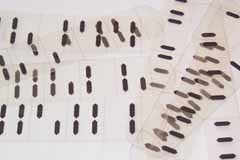 where 'abs' means taking the absolute value, and 'round' indicates rounding DOWN to the nearest integer, 'Y' is your guess, and 'A' is the actual answer (don't worry if the formula is confusing... it'll work, trust me).
where 'abs' means taking the absolute value, and 'round' indicates rounding DOWN to the nearest integer, 'Y' is your guess, and 'A' is the actual answer (don't worry if the formula is confusing... it'll work, trust me).
#9. Digital ManipulationUse the provided plastic strips and try to create as many "digital" numbers as possible. Score will depend on the number of digits created (a score of at least 100 will be possible).#10. Digits in a Box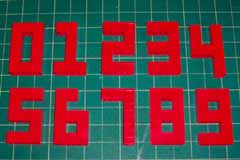 Note that this is a replacement for an earlier described puzzle.
Note that this is a replacement for an earlier described puzzle.
Try to place as many of the digit blocks in the box at the same time. The blocks must fit fully within the box's interior (not jutting out the top). The size of the box to fill will not be revealed until the day of the Party. You will receive 100 Points minus 10 points for each block that you cannot fit inside the box (regardless of the digit's value).
Back to Eric's Main Puzzle Party Webpage |
 Anyway, there was quite a variety of puzzles (briefly described below), and afterwards an informal polling showed that many people had different favorites and least favorites (Betty Senger and Mark Brady actually really liked the Su-Domino-Ku despite it trouncing everyone). My personal favorites as the creator were Digits In A Box and Digital Manipulation (both were received well by players too).
Anyway, there was quite a variety of puzzles (briefly described below), and afterwards an informal polling showed that many people had different favorites and least favorites (Betty Senger and Mark Brady actually really liked the Su-Domino-Ku despite it trouncing everyone). My personal favorites as the creator were Digits In A Box and Digital Manipulation (both were received well by players too).

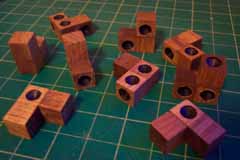 Use the nine "L"-shaped pieces to construct a large 6-sided die that looks exactly like the "target die" provided. Your construction must match the target exactly (i.e. the faces 1,2,3,...,6 must be arranged in the same way, and even the pips on each face must orient each number correctly).
Use the nine "L"-shaped pieces to construct a large 6-sided die that looks exactly like the "target die" provided. Your construction must match the target exactly (i.e. the faces 1,2,3,...,6 must be arranged in the same way, and even the pips on each face must orient each number correctly).
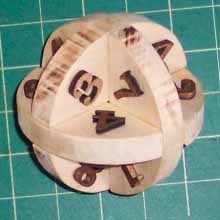 The second (and final) Decathlon Puzzle which will involved a paper/page-based challenge. I won't reveal too much about this one, except that is a wordsearch... of sorts. Each found word will be worth 4 Points.
The second (and final) Decathlon Puzzle which will involved a paper/page-based challenge. I won't reveal too much about this one, except that is a wordsearch... of sorts. Each found word will be worth 4 Points.
